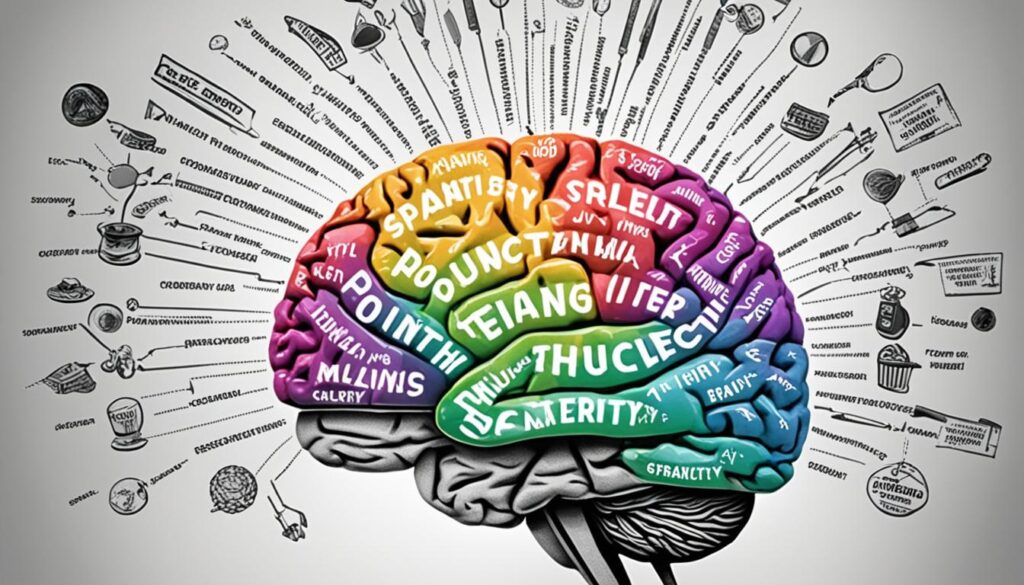The impact of a poverty mindset on consumer behavior trends is a significant area of study. Understanding how the poverty mindset influences consumer psychology, spending patterns, and money mindset is crucial for businesses to effectively engage and serve consumers with a poverty mindset.
Research shows that social developments, such as the increasing use of technology and the “always on” mentality, are shaping consumer behavior. Empowered customers, the exchange and monetization of private data, the evolving needs of an aging society, and the rise of the sharing economy are also influencing how people make purchasing decisions.
By recognizing the unique needs and perspectives of individuals with a poverty mindset, businesses can tailor their strategies to cater to this specific consumer segment and foster meaningful connections. Understanding the impact of a poverty mindset on consumer behavior is essential for businesses to thrive in an ever-changing market.
Key Takeaways:
- A poverty mindset significantly impacts consumer behavior and decision making.
- Social developments and changing consumer expectations shape how people make purchasing decisions.
- Understanding the unique needs of consumers with a poverty mindset is crucial for businesses.
- A poverty mindset can influence spending patterns and consumer psychology.
- Businesses should tailor their strategies to effectively engage and serve consumers with a poverty mindset.
The Influence of Scarcity on Decision Making
Scarcity has a significant impact on decision making, especially in the context of poverty. Studies have shown that individuals experiencing scarcity often exhibit a scarcity mindset, which affects their thinking processes and behavioral patterns.
The scarcity mindset leads to a heightened focus on immediate needs and goals, making individuals more prone to making suboptimal decisions that may perpetuate the poverty cycle. This mindset can affect both cognitive processes, such as attention and inhibitory control, as well as behavioral patterns, including lower aspirations and motivation, diminished self-regulation, and aversion to risk-taking.
“When you constantly worry about not having enough, it’s difficult to think long-term or make choices that can break the poverty cycle.”
Individuals with a scarcity mentality tend to prioritize survival and short-term gains over long-term financial habits. This scarcity mentality can be deeply ingrained, influenced by generational poverty and limited access to resources and opportunities.
Furthermore, the scarcity mentality and poverty cycle can create a vicious cycle. Limited financial resources lead to limited choices and opportunities, which in turn reinforce the scarcity mindset and perpetuate the cycle of poverty.
In order to mitigate the negative effects of scarcity on decision making, it is important to address both the psychological and external factors that contribute to the scarcity mindset. This can include providing education and resources to build financial literacy and resilience, creating supportive and inclusive social structures, and implementing policies that promote equal access to opportunities.
Key Factors Influencing Decision Making in Scarcity:
- Immediate needs and goals overriding long-term considerations
- Lower aspirations and motivation due to limited resources
- Diminished self-regulation leading to impulsive decision making
- Higher aversion to risk-taking
Understanding the influence of scarcity on decision making is crucial for individuals, policymakers, and businesses alike. By recognizing and addressing the underlying factors that contribute to the scarcity mindset, we can empower individuals to make informed decisions and break free from the cycle of poverty.
The Psychological and Neural Processes of Scarcity
The experience of poverty and scarcity can have profound psychological and neural effects on decision making. Research has shown that individuals living in poverty exhibit changes in cognitive processes, including poorer performance on tasks measuring selective attention and inhibitory control. These individuals also show differences in higher-level thinking processes, such as reasoning and learning, which can impact decision making.
Neuroimaging studies have revealed that a scarcity mindset affects neural mechanisms involved in goal-directed decision making, with increased activity in the orbitofrontal cortex (OFC) and decreased activity in the dorsolateral prefrontal cortex (dlPFC). This suggests that scarcity can alter how individuals evaluate and make choices, leading to suboptimal decisions.

“The scarcity mindset affects neural mechanisms involved in goal-directed decision making.”
The Impact on Cognitive Processes
Poverty and scarcity can disrupt cognitive processes essential for effective decision making. Individuals facing poverty often struggle with selective attention, making it challenging to prioritize and focus on relevant information. This can lead to overlooking crucial details and hindering their ability to make informed decisions.
Moreover, inhibitory control, the ability to suppress impulsive responses, may also be impaired in those experiencing scarcity. This can result in impulsive decision making and difficulty resisting short-term gratification at the expense of long-term goals.
The Effect on Higher-Level Thinking
Beyond cognitive processes, scarcity also influences higher-level thinking involved in decision making. Poverty and scarcity can affect reasoning abilities, making it harder to evaluate options and anticipate potential outcomes. Additionally, learning processes may be altered, impacting individuals’ ability to adapt and make better-informed decisions in the future.
These psychological changes, rooted in poverty and scarcity, contribute to a scarcity mindset that influences decision making and perpetuates the cycle of poverty.
The Impact of Scarcity Mindset on Consumer Choice
Consumer choice is greatly influenced by a scarcity mindset. Studies have shown that individuals experiencing a scarcity mindset exhibit different decision-making processes when it comes to consumer choices.
A scarcity mindset can lead to increased engagement and deliberation in decision-making, as individuals become more attuned to the value and scarcity of resources. This heightened scrutiny of available options is driven by a deep-rooted fear of scarcity and an innate desire to maximize the perceived utility of their choices.
In the context of consumer behavior, a scarcity mindset can manifest in several ways. One common effect is the prioritization of short-term gratification over long-term goals. Individuals with a scarcity mindset tend to focus on meeting their immediate needs and desires rather than considering the potential long-term consequences of their choices.
Furthermore, a scarcity mindset influences preferences for hedonic versus utilitarian products. When faced with limited resources, individuals are more likely to prioritize products or services that provide immediate pleasure or gratification. This can lead to impulsive buying decisions and a neglect of products that cater to long-term needs or functional benefits.
“A scarcity mindset drives individuals to seize opportunities, even if it means sacrificing rational decision-making.”
Neural processes also play a vital role in shaping consumer choices influenced by scarcity mindset. The orbitofrontal cortex (OFC) and dorsolateral prefrontal cortex (dlPFC) are key regions involved in decision-making processes. The OFC is responsible for evaluating the value and desirability of different options, while the dlPFC helps individuals make goal-directed choices based on their priorities and preferences.
By understanding the impact of a scarcity mindset on consumer choice, businesses can tailor their strategies to effectively engage and cater to consumers with this mindset. They can create a sense of urgency, scarcity, and exclusivity to appeal to individuals with a scarcity mindset, while also offering products and services that address their immediate needs and desires.
| Effects of Scarcity Mindset on Consumer Choice | Examples |
|---|---|
| Increased engagement and deliberation in decision-making | Spending more time researching options before making a purchase |
| Preference for hedonic products | Choosing to buy luxury items that provide immediate pleasure |
| Neglect of utilitarian products | Overlooking functional products that cater to long-term needs |
| Focus on immediate needs and desires | Buying impulsively to satisfy immediate gratification |
The impact of scarcity mindset on consumer choice is a complex phenomenon influenced by psychological, social, and neural factors. By acknowledging and understanding these influences, businesses can develop strategies that resonate with individuals experiencing a scarcity mindset, leading to increased consumer engagement and satisfaction.

How Do Cultural Influences Impact Consumer Behavior in Relation to the Poverty Mindset?
Cultural influences on poverty mindset play a significant role in shaping consumer behavior. In some cultures, frugality and saving money are highly valued, leading individuals to be more cautious with their spending. On the other hand, in cultures that emphasize material wealth, consumer behavior may be driven by a desire to display affluence.
Conclusion
The poverty mindset has a significant impact on consumer behavior and decision making. Studies have consistently shown that individuals with a scarcity mindset, often accompanied by poverty, experience changes in their thinking processes and behavioral patterns, leading to specific consumer choices. This mindset is characterized by alterations in cognitive processes, including attention and inhibitory control, as well as behavioral patterns like lower aspirations, diminished self-regulation, and a tendency to avoid risk-taking.
Furthermore, the scarcity mindset strongly influences consumer choices, with individuals prioritizing immediate needs and desires over long-term goals. As a result, businesses need to be aware of and understand the psychological and neural processes that underlie the poverty mindset. By doing so, they can develop strategies that effectively engage and serve consumers with a poverty mindset, aligning their products and services with the unique needs and preferences of this demographic.
Ultimately, recognizing the impact of the poverty mindset on consumer behavior and decision making is crucial for businesses to successfully navigate the market. By considering the specific challenges and preferences associated with a scarcity mindset, companies can tailor their marketing efforts, product offerings, and customer experiences to better cater to the needs of individuals grappling with poverty. Understanding and addressing the psychological aspects of the poverty mindset will enable businesses to adapt and thrive in an ever-changing consumer landscape.
FAQ
How does a poverty mindset impact consumer behavior trends?
A poverty mindset can influence spending patterns, money mindset, and consumer psychology. It can lead individuals to focus on immediate needs, make suboptimal decisions, exhibit lower aspirations and motivation, and have a aversion to risk-taking.
Does scarcity affect decision making?
Yes, scarcity can have a significant impact on decision making. Scarcity mindset, financial habits, scarcity mentality, and the poverty cycle can lead to changes in thinking processes and behavioral patterns, resulting in suboptimal choices.
What are the psychological and neural processes of scarcity?
Research has shown that scarcity affects cognitive processes, such as attention and inhibitory control, as well as higher-level thinking processes like reasoning and learning. Neuroimaging studies have revealed changes in neural mechanisms, including increased activity in the orbitofrontal cortex (OFC) and decreased activity in the dorsolateral prefrontal cortex (dlPFC).
How does scarcity mindset impact consumer choice?
The scarcity mindset can influence consumer choices by increasing engagement and deliberation in decision making. Individuals become more attuned to the value and scarcity of resources and may prefer hedonic products that meet immediate needs and desires. Neural mechanisms, such as the OFC and dlPFC, play a role in these decision-making processes.
What is the overall impact of the poverty mindset on consumer behavior?
The poverty mindset affects various aspects of consumer behavior, including decision making, spending patterns, and consumer choices. Understanding the psychological and neural processes underlying the poverty mindset can help businesses develop strategies to better engage and serve consumers with a poverty mindset.
Source Links
- https://www.spiceworks.com/marketing/customer-experience/guest-article/six-socioeconomic-trends-influencing-customer-behavior-and-the-impact-on-customer-engagement/
- https://www.lse.ac.uk/business/consulting/assets/documents/how-poverty-affects-peoples-decision-making-processes.pdf
- https://www.ncbi.nlm.nih.gov/pmc/articles/PMC6575633/

